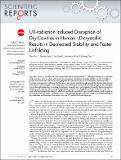UV-radiation Induced Disruption of Dry-Cavities in Human γD-crystallin Results in Decreased Stability and Faster Unfolding
Author(s)
Xia, Zhen; Yang, Zaixing; Huynh, Tien; King, Jonathan Alan; Zhou, Ruhong
DownloadXia-2013-UV-radiation induced disruption.pdf (2.020Mb)
PUBLISHER_CC
Publisher with Creative Commons License
Creative Commons Attribution
Terms of use
Metadata
Show full item recordAbstract
Age-onset cataracts are believed to be expedited by the accumulation of UV-damaged human γD-crystallins in the eye lens. Here we show with molecular dynamics simulations that the stability of γD-crystallin is greatly reduced by the conversion of tryptophan to kynurenine due to UV-radiation, consistent with previous experimental evidences. Furthermore, our atomic-detailed results reveal that kynurenine attracts more waters and other polar sidechains due to its additional amino and carbonyl groups on the damaged tryptophan sidechain, thus breaching the integrity of nearby dry center regions formed by the two Greek key motifs in each domain. The damaged tryptophan residues cause large fluctuations in the Tyr-Trp-Tyr sandwich-like hydrophobic clusters, which in turn break crucial hydrogen-bonds bridging two β-strands in the Greek key motifs at the “tyrosine corner”. Our findings may provide new insights for understanding of the molecular mechanism of the initial stages of UV-induced cataractogenesis.
Date issued
2013-03Department
Massachusetts Institute of Technology. Department of BiologyJournal
Scientific Reports
Publisher
Nature Publishing Group
Citation
Xia, Zhen, Zaixing Yang, Tien Huynh, Jonathan A. King, and Ruhong Zhou. “UV-Radiation Induced Disruption of Dry-Cavities in Human γD-Crystallin Results in Decreased Stability and Faster Unfolding.” Sci. Rep. 3 (March 27, 2013).
Version: Final published version
ISSN
2045-2322